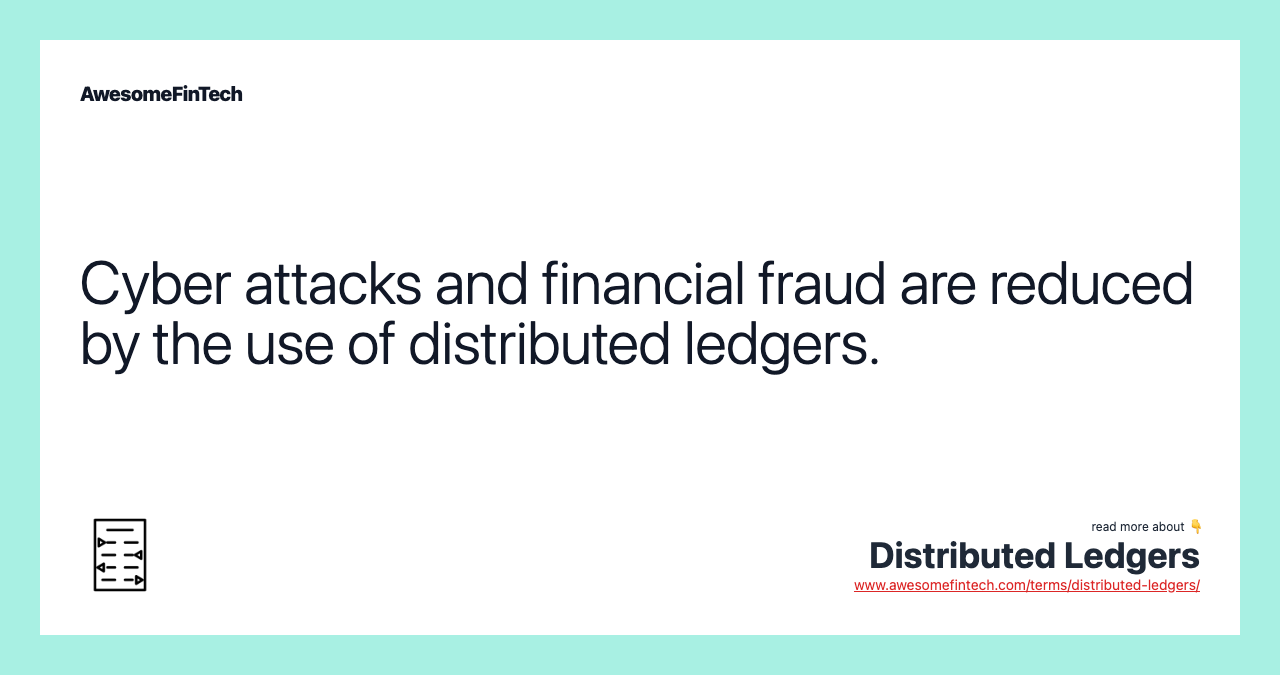Distributed Ledgers
A distributed ledger is a database that is consensually shared and synchronized across multiple sites, institutions, or geographies, accessible by multiple people. A distributed ledger can be described as a ledger of any transactions or contracts maintained in decentralized form across different locations and people, eliminating the need for a central authority to keep a check against manipulation. A distributed ledger stands in contrast to a centralized ledger, which is the type of ledger that most companies use. While centralized ledgers are prone to cyber-attack, distributed ledgers are inherently harder to attack because all of the distributed copies need to be attacked simultaneously for an attack to be successful. A distributed ledger can be described as a ledger of any transactions or contracts maintained in decentralized form across different locations and people.

What Are Distributed Ledgers?
A distributed ledger is a database that is consensually shared and synchronized across multiple sites, institutions, or geographies, accessible by multiple people. It allows transactions to have public "witnesses". The participant at each node of the network can access the recordings shared across that network and can own an identical copy of it. Any changes or additions made to the ledger are reflected and copied to all participants in a matter of seconds or minutes.
A distributed ledger stands in contrast to a centralized ledger, which is the type of ledger that most companies use. A centralized ledger is more prone to cyber attacks and fraud, as it has a single point of failure.
Underlying distributed ledgers is the same technology that is used by blockchain, which is the technology that is used by bitcoin. Blockchain is a type of distributed ledger used by bitcoin.





Understanding Distributed Ledgers
Since ancient times, ledgers have been at the heart of economic transactions, with the purpose of recording contracts, payments, buy-sell deals, or moving assets or property. The journey which began with recording on clay tablets or papyrus made a big leap with the invention of paper.
Over the last couple of decades, computers have provided the process of record-keeping and ledger maintenance with great convenience and speed. Today, with innovation, the information stored on computers is moving towards much higher forms, which is cryptographically secured, fast, and decentralized. Companies can take advantage of this technology in many forms, one way being through distributed ledgers.
A distributed ledger can be described as a ledger of any transactions or contracts maintained in decentralized form across different locations and people, eliminating the need for a central authority to keep a check against manipulation. In this manner, a central authority is not needed to authorize or validate any transactions.
All the information on the ledger is securely and accurately stored using cryptography and can be accessed using keys and cryptographic signatures. Once the information is stored, it becomes an immutable database, which the rules of the network govern.
Advantages of Distributed Ledgers
While centralized ledgers are prone to cyber-attack, distributed ledgers are inherently harder to attack because all of the distributed copies need to be attacked simultaneously for an attack to be successful. Furthermore, these records are resistant to malicious changes by a single party. By being difficult to manipulate and attack, distributed ledgers allow for extensive transparency.
Distributed ledgers also reduce operational inefficiencies, speed up the amount of time a transaction takes to complete, are automated, and therefore function 24/7, all of which reduce overall costs for the entities that use them.
Distributed ledgers also provide for an easy flow of information, which makes an audit trail easy to follow for accountants when they conduct reviews of financial statements. This helps remove the possibility of fraud occurring on the financial books of a company. The reduction in the use of paper is also a benefit to the environment.
Use of Distributed Ledgers
Distributed ledger technology has great potential to revolutionize the way governments, institutions, and corporations work. It can help governments in tax collection, issuance of passports, recording land registries, licenses, and the outlay of Social Security benefits, as well as voting procedures.
The technology is making waves in several industries, including:
While the distributed ledger technology has multiple advantages, it’s in a nascent stage and is still being explored in how to adopt it in the best possible way. Though one thing is clear, that the future format of centuries-old ledgers is to be decentralized.
Related terms:
Audit Trail
An audit trail tracks accounting data to its source for verification. Learn how companies use auditing to reconcile accounts and detect fraud. read more
Bitcoin Maximalism
Bitcoin maximalists favor bitcoin over other cryptocurrencies and are unapologetically in favor of a bitcoin monopoly in the future. read more
Bitcoin
Bitcoin is a digital or virtual currency created in 2009 that uses peer-to-peer technology to facilitate instant payments. read more
Blockchain : What You Need to Know
A guide to help you understand what blockchain is and how it can be used by industries. You've probably encountered a definition like this: “blockchain is a distributed, decentralized, public ledger." But blockchain is easier to understand than it sounds. read more
Cryptocurrency : What Is Cryptocurrency?
A cryptocurrency is a digital or virtual currency that uses cryptography and is difficult to counterfeit because of this security feature. read more
Distributed Ledger Technology (DLT)
Distributed Ledger Technology, such as blockchain, is all about the idea of a ‘"decentralized" network against the conventional "centralized" mechanism. read more
Fraud
Fraud, in a general sense, is purposeful deceit designed to provide the perpetrator with unlawful gain or to deny a right to a victim. read more
General Ledger : Uses & How It Works
A general ledger is the record-keeping system for a company’s financial data, with debit and credit account records validated by a trial balance. read more
On-Chain Governance
On-chain governance is a governance system for blockchain in which rules are hardcoded into protocol. read more